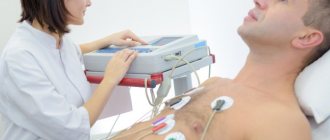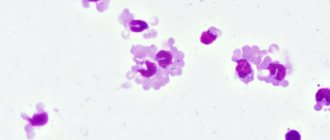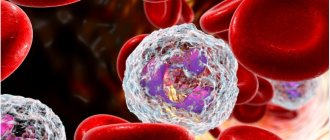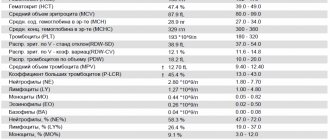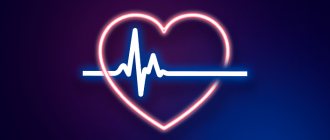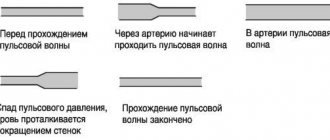Snezhana Shabanova
February 29, 2012
Heart rate (HR), often called “pulse,” shows how many times per minute the heart beats. This rate varies depending on what the person is doing. During sleep, your heart rate is significantly lower than during running. Despite the fact that heart rate and pulse are expressed in the same numbers, there is a technical difference between these two indicators. Heart rate
- This is an indicator of how many heartbeats occur in a certain period of time, usually per minute.
The pulse
is an indicator of the movement of blood through the arteries. By placing your finger on a large artery, you can feel the heart pumping blood. Doctors use heart rate to monitor a person's health. And people involved in sports - to determine the effectiveness of training.
How does heart rate differ from pulse?
As already mentioned, heart rate shows how many contractions the heart makes, namely its lower parts - the ventricles - per minute.
The pulse, or heart rate, is the number of times the artery dilates as the heart pumps blood per minute. Blood passing through the vessels during the contraction of the heart creates a bulge in the arteries, which is determined by touch.
The pulse value and heart rate can indeed be equal, but not always, but only in healthy people.
For example, with rhythm disturbances, the heart contracts erratically. If it contracts twice in a row, then the left ventricle does not have time to fill with blood. Thus, the second contraction occurs when the ventricle is empty and no blood is ejected from it into the aorta and peripheral vessels. Therefore, the pulse in the arteries will not be heard while the heart is contracting. With atrial fibrillation and some other diseases, the heart rate does not correspond to the pulse rate. This phenomenon is called pulse deficiency. In such cases, heart rate cannot be determined by measuring the pulse. This can only be done by listening to the heartbeat, for example using a phonendoscope.
In pulse deficiency, the heart rate is greater than the pulse. This usually happens with atrial fibrillation and extrasystole
ECG indicators
The main indicators of the electrocardiogram characterizing the work of the myocardium are waves, segments and intervals.
Serrations are all sharp and rounded bumps written along the vertical Y axis, which can be positive (upward), negative (downward), or biphasic. There are five main waves that are necessarily present on the ECG graph:
- P – recorded after the occurrence of an impulse in the sinus node and sequential contraction of the right and left atria;
- Q – recorded when an impulse appears from the interventricular septum;
- R, S – characterize ventricular contractions;
- T - indicates the process of relaxation of the ventricles.
Segments are areas with straight lines, indicating the time of tension or relaxation of the ventricles. There are two main segments in the electrocardiogram:
- PQ – duration of ventricular excitation;
- ST – relaxation time.
An interval is a section of an electrocardiogram consisting of a wave and a segment. When studying the PQ, ST, QT intervals, the time of propagation of excitation in each atrium, in the left and right ventricles is taken into account.
Norm
Normal heart rate in adults ranges from 60 to 80 beats per minute. If the frequency is less than 60, it is bradycardia, if above 80, it is tachycardia.
Resting heart rate will vary depending on:
- person's age;
- his gender;
- body size;
- fitness.
In newborns, this figure is usually 120-140 beats per minute. If the child is premature, the value will be higher - from 140 to 160. In children by one year it decreases to 110-120, by five years - to 100, by 10 - to 90, by 13 - to 80.
In a trained person, the heart rate is lower than normal and averages about 50, while in those leading a sedentary lifestyle it can reach 100 beats at rest.
In women, the heart rate is approximately 6 beats higher than in men, and increases even more before the onset of menstruation.
In a healthy older person, the normal heart rate is usually 80 beats. If this figure rises to 160, then this indicates the presence of a serious illness.
Live broadcast: “Pulse. What should it be like for a healthy person?”
Arterial pulse is one of the important indicators of the functioning of our cardiovascular system and the human body as a whole.
Pulse (pulsus, Latin “beat”) is the oscillatory movement of the walls of the arteries, which occurs depending on the contractions of the heart and the elasticity of the walls of the vessels. In other words, when the heart muscle contracts during systole, blood from the heart chamber is released into the arterial bed, this leads to an increase in pressure in the arteries and their expansion. During the relaxation of the heart muscle, in diastole, the pressure in the arteries decreases. We can evaluate the vibrations of the vessel wall that arise by palpating (feeling) the arteries located shallowly under the skin.
The pulse can be assessed in the carotid, radial, brachial, femoral, popliteal arteries, and arteries of the feet. Examination of the pulse by a doctor includes determination of a number of characteristics, such as frequency, rhythm, filling, tension, amplitude, duration of the systolic wave, etc.
The most common and convenient way to independently assess the pulse is to determine it on the radial artery, on the inside of the wrist on the side of the thumb.
How to determine heart rate?
Pulse rate/heart rate is calculated as the number of beats/contractions in one minute, 60 seconds. In some cases, with severe irregularity (arrhythmia) of the pulse, the frequency is counted for 3 minutes, followed by dividing the result by 3 to determine the average value.
Currently, there are a large number of modern technical means that allow almost every person to determine, without extra effort and without the participation of a specialist, the frequency and rhythm of the pulse at rest and during physical activity: heart rate monitors built into sports watches, trackers, mobile phones. A scale for determining pulse rate and its regularity is also found in most modern automatic devices for determining blood pressure (tonometers).
How accurate are heart rate measurements using sports watches and heart rate monitors?
Most modern devices use the method of optical plethysmography (photoplethysmography). The method is based on the ability of blood to reflect red light and absorb green light. The optical sensor on the back of the watch emits light onto the wrist using LEDs, and measures the amount of light scattered by the bloodstream, thus determining the blood flow on the wrist.
It is believed that optical sensors accurately determine the pulse, incl. when walking and running. However, measurements may become less accurate when your heart rate is very high, above 150 beats per minute, in cold weather (due to decreased blood flow to the wrist). There are other situations that can interfere with the sensor’s operation and lead to errors in heart rate measurement: having a tattoo on the wrist, the watch not fitting tightly to the skin, working out at the gym. Rhythmic movements, such as running or cycling, provide more accurate results compared to tennis or boxing, where athletes move irregularly.
Is it possible to detect heart rhythm disturbances using modern smartwatches and fitness bracelets?
Modern “smart watches” equipped with an ECG recording function allow not only to track the heart rate and give an idea of its rhythm, but can also detect some heart rhythm disturbances. In particular, Apple and AliveCor devices with ECG measurement support are certified to detect heart rhythm disorders such as atrial fibrillation. However, smartwatches are not designed to detect all irregular heart rhythms and cannot be relied upon entirely. They may miss serious problems or cause people to worry unnecessarily about possible heart problems due to so-called “false positives.” In any case, only an examination by a specialist - a cardiologist - can accurately determine the presence of heart rhythm disturbances and their nature. If the watch goes off repeatedly or, more seriously, the person feels unwell, it is imperative to consult a cardiologist. At the EXPERT clinic, an examination is carried out to study the functioning of the heart (24-hour monitoring of ECG and blood pressure, echocardiography), based on the results of which a specialist will give an opinion and recommendations.
Are the pulse rate and heart rate always the same?
In a healthy person, the pulse rate and heart rate are the same, which means that each contraction of the heart results in sufficient blood flow into the arterial system. However, in some pathological conditions, the pulse rate and heart rate may differ; the pulse rate may become less than the heart rate. In this case, it is necessary to contact a specialist and conduct a comprehensive medical examination.
What is a normal resting heart rate/pulse rate?
Resting heart rate/pulse rate depends on many factors, such as age, gender, body weight, average daily sleep duration, smoking, consumption of caffeinated drinks, and level of physical activity. Your heart rate may be affected by certain medications.
In children, normal heart rate values differ from those in adults and significantly depend on age, so in a child of 1-3 months, the heart rate is normally 145-170 beats/min, in 3-6 months - 130-150 beats/min, and at 6-12 months - 120-140 beats/min.
As you get older, your heart rate decreases and the average adult (over 18 years old) should be 60-90 beats per minute at rest. Women's resting heart rate is on average 6-10 beats per minute higher than men's.
A frequent pulse, more than 90 beats/min, is called tachycardia, a rare pulse, less than 60 beats/min, is called bradycardia.
It should be noted that the heart rate at rest in a healthy person is variable and can normally fluctuate over time (day, week, month, year) in a fairly wide range, often going beyond the values accepted as the norm, as well as beyond the framework of the “individual norm”. The heart rate slows down at night, during sleep, and the rate increases after eating. During the day, heart rate gives two rises - the first at about 11 o'clock in the afternoon, the second between 6 and 8 o'clock in the evening. Heart rate can also change with a sharp change in body position or with psycho-emotional stress. Heart rate also has slight seasonal fluctuations; in winter, heart rate is on average higher than in summer.
For trained people who are actively involved in “aerobic”, cyclic endurance sports (skiing, swimming, marathon, cycling, etc.), the resting heart rate is on average lower than that of an untrained person. A pulse of 50-55 beats per minute at rest, and sometimes 40-50 beats per minute, is considered normal for this category of adults and is not accompanied by any unpleasant sensations. In an untrained person, such a heart rate is regarded as bradycardia and requires additional examination by a cardiologist.
Alarming symptoms with a low pulse are weakness, dizziness, fainting, and presyncope. The appearance of these symptoms requires immediate contact with a specialist.
What is the normal heart rate during sleep?
In a healthy person, the heart rate during sleep is lower than during wakefulness. This is explained by the predominance of the tone of the parasympathetic nervous system during sleep. In a healthy adult, the average heart rate during sleep is approximately 18-20 beats/min less than the average daytime heart rate. At the same time, the established average values of heart rate during sleep and wakefulness differ depending on gender and age.
The pulse rate during sleep in a healthy adult can vary as well as during wakefulness, because... sleep is a heterogeneous, dynamic and complexly organized process, consisting of 5 stages (phases) varying in depth. The duration of these stages varies from person to person and is influenced by many factors, both internal and external. This may affect heart rate fluctuations during sleep. The first 4 phases, the phases of slow-wave sleep, are characterized by a gradual decrease in heart rate. During stage five, REM sleep, when you dream, your breathing rate and heart rate may increase. In addition, psycho-emotional or physical stress before bedtime, stress, drinking strong tea or coffee, smoking, drinking alcohol, and a number of medications can cause an increase in heart rate at night.
If attacks of rapid heartbeat during sleep occur regularly without connection with external provoking factors, are accompanied by awakening, a feeling of shortness of breath, discomfort, heaviness or pain in the chest, behind the sternum, it is necessary to undergo an examination to exclude heart disease, endocrine disorders (hyperthyroidism, diabetes mellitus) , inflammatory diseases, anemia, increased blood pressure during sleep and sleep-disordered breathing. The entire range of activities and consultations of specialists involved in the problem can be completed in our clinic.
Pulse rhythm.
A healthy person has a rhythmic pulse, that is, pulse waves follow one another at regular intervals. In case of heart rhythm disturbances (arrhythmias), pulse waves usually follow at irregular intervals and the pulse becomes arrhythmic. In some cases, arrhythmia may be accompanied by a feeling of discomfort in the heart area, difficulty breathing, a feeling of “somersaults”, blows to the chest, dizziness and even loss of consciousness. In this situation, it is advisable to contact a cardiologist to clarify the nature of heart rhythm disturbances and exclude cardiac pathology.
What is the normal heart rate during exercise?
Currently, much attention is paid to regular physical exercise to prevent the development of cardiovascular diseases, as well as as part of comprehensive cardiac rehabilitation. The benefits of regular physical activity have been proven in large scientific studies. It is very important that the recommended physical activity is safe for humans. Intense, inadequate physical activity in untrained people can lead to the development of various complications.
The optimal level of physical activity is determined individually and depends on the functionality of the cardiovascular and respiratory systems, age, and characteristics of physical development. For proper planning of the intensity of physical activity, one of the main criteria is determining the heart rate. The intensity of physical activity is expressed as a percentage of the maximum heart rate. In this case, the maximum heart rate is the highest pulse frequency at which normal heart function is maintained.
There are many formulas for calculating your maximum heart rate. Traditionally, the formula is used: HRmax = 220 – “Age”.
However, it must be taken into account that the formulas calculate statistically averaged values, while individual values of maximum heart rate depend not only on age or gender. As already mentioned, the maximum heart rate is also influenced by the degree of training and anthropometric indicators.
When performing physical exercises, there are five levels of training intensity or pulse zones:
- moderate exercise (pulse 50–60% of maximum heart rate);
- “weight control” (pulse 60–70% of maximum heart rate);
- aerobic zone (pulse 70–80% of maximum heart rate);
- anaerobic training (pulse 80–90% of maximum heart rate);
- maximum load (pulse 90–100% of maximum heart rate).
To calculate your maximum heart rate during training, you can use the Karvonen Formula:
Heart rate during exercise = (maximum heart rate - resting heart rate) x intensity (in percent) + resting heart rate
The moderate-intensity zone is best suited for those who are either just starting their training or have a low level of general physical fitness. The initial level of physical activity in untrained people should not cause an increase in heart rate of more than 30 beats per minute compared to the resting state. The level of exercise should be increased gradually over 1-3 weeks depending on tolerance. Training in the anaerobic zone and in the maximum load zone is suitable for well-trained individuals and professional athletes.
It is important to remember that before starting training, it is necessary to undergo a comprehensive medical examination, which allows, first of all, to exclude diseases of the cardiovascular system, assess the functionality of the heart and respiratory system, and also determine the individual maximum heart rate.
You need to know that when performing physical activity, the appearance of such symptoms as: discomfort, unpleasant sensations, pain behind the sternum or in the left half of the chest, weakness, fatigue, headache, dizziness, interruptions in heart function, severe sweating; - is a sign of inadequate physical activity and may be a manifestation of pathology of the cardiovascular system. In this case, it is necessary to immediately contact a cardiologist.
You can more accurately determine your heart rate and the presence of heart rhythm disturbances (arrhythmias) using electrocardiography. If it is necessary to assess heart rate at different times of the day and under different loads, 24-hour electrocardiogram monitoring is performed. To assess the response of the cardiovascular system to stress and determine the individual maximum heart rate, tests are carried out with dosed physical activity. It is important to remember that only a specialist can determine the need and scope of examinations.
When it changes
The value is not the same at different times of the day. The indicator changes throughout the day depending on the following factors:
- during physical activity;
- in moments of anger, fear, excitement and other emotions;
- depending on body position (lying, sitting, standing);
- after eating;
- after taking certain medications.
The heart rate increases after eating food, especially hot and protein foods.
When body temperature rises to 37 degrees, it increases by 20 beats.
During sleep it decreases by five to seven units.
Heart rate increases by about 10% when a person is sitting and by 20% when standing.
Heart rate increases:
- when in a stuffy, hot room;
- during stress;
- during physical activity.
conclusions
By counting the pulse and heart rate, one can judge the functioning of the cardiovascular system, the body’s adaptation to the influence of provoking factors in the form of physical and psycho-emotional stress, and the state of health in general. Currently, pulse oscillations are measured both by palpation (by touch) and using special devices. The normal pulse of a person is assessed by year, taking into account constitution and gender. If abnormalities, tachycardia or bradycardia are detected, additional examination by a general practitioner or cardiologist is indicated.
Causes of tachycardia and bradycardia
If your heart rate at rest is not normal, this may be a sign of illness. Usually, other manifestations of the disease are also present.
If tachycardia is accompanied by symptoms such as dizziness, shortness of breath, weakness, fainting, then the following cannot be ruled out:
- infectious disease;
- heart disease;
- onset of stroke;
- endocrine disorders;
- diseases of the nervous system;
- tumor processes;
- anemia.
Bradycardia can normally be observed in the following cases:
- for athletes (40 strokes);
- in people engaged in heavy physical labor;
- when taking certain medications.
It can also be a sign of illness:
- poisoning;
- heart attack;
- stomach ulcers;
- hypothyroidism;
- myocardial inflammation.
Pulse below 60 beats: what to do
If the pulse is below 60 beats and there are no complaints about the state of health, then nothing needs to be done, since this means that the body has adapted well to such a heart rate; an increase in heart rate is not required. For pre-fainting and severe weakness in a patient with normal and low blood pressure, use:
- sweet and strong tea or coffee;
- actively rubbing the ears with the palms;
- a few slices of dark chocolate;
- shower with alternating cold and hot water;
- tinctures of eleutherococcus, ginseng (15 drops per 50 ml of water).
For high blood pressure, the best help is diuretics to increase the heart rate - Hypothiazide or Furosemide; it is also necessary to review the dose of tablets taken (Concor, Corinfar, Anaprilin) when the pulse is 60. All these changes to the treatment plan can only be made by the attending physician.
Drugs
Drugs for a pulse of 60 are prescribed after the cause of the slowing of the rhythm is discovered, since heart disease requires medications for:
- improving metabolism in the myocardium - Mildronate, Carnitine, Preductal;
- activation of oxygen absorption – Ubiquinone, Kudesan;
- regulation of mineral balance – Magnerot, Magne B6;
- increasing energy production – Riboxin, Potassium orotate;
- additional intake of vitamins - Neurovitan, Vitamax plus.
With low thyroid function, the rhythm can be increased only with the help of thyroxine analogues (Eutirox, L-thyroxine). For neurosis and pulse 60, use natural-based sedatives - Motherwort forte, Persen.
Traditional methods
With the help of plants, it is possible to speed up the rhythm of heart contractions if bradycardia is associated with fatigue, menopause, stress, or the recovery period after an infection. Use the following recipes:
- a collection of St. John's wort, lemon balm and mint in equal parts is mixed with green tea (for 50 g of leaves 10 g of a mixture of herbs) and brewed in the usual way, take a glass 2-3 times a day;
- mix 2 tablespoons of ginseng roots and one each of elecampane rhizomes and mint leaves, then take a tablespoon of the mixture of crushed plants and pour 300 ml of boiling water in a thermos overnight, take 100 ml before meals 3 times a day for a month;
- Pine nuts are poured into a jar and filled to the top with honey, use a tablespoon 2 times a day.
A pulse of 60 may be normal if you feel well. If there are signs of deterioration in blood circulation, then an examination by a therapist or cardiologist is necessary to find the cause. It will be possible to speed up the pulse only after identifying and treating the disease that caused bradycardia.
How to measure
Heart rate is measured at rest in a quiet and warm room. To carry out the procedure, you will need a stopwatch and an assistant. Approximately an hour before the measurement, you need to eliminate physical and emotional stress and smoking. It is not recommended to take medications or drink alcoholic beverages.
To measure your heart rate, you need to place your palm on your chest
The person whose heart rate will be measured can lie down or sit down. After he takes the desired position, you need to lie down or sit quietly for five minutes.
The assistant places a clean, dry palm on the chest below the left nipple for a man and under the mammary gland for a woman.
It is necessary to determine the impact on the chest at the apex of the heart, which is called the apical impulse. It is heard in half of healthy people in the fifth intercostal space if the person is standing. If you can’t determine it, it means it falls on an edge.
After this, you need to take a stopwatch and start counting the person’s heartbeats for a minute. If the rhythm is incorrect, you need to do this for three minutes, then divide the resulting number by three.
Heart rate can be measured in other places, where the arteries come close to the surface. The pulsation is clearly palpable:
- on the neck,
- under the collarbone,
- at the temple,
- on shoulders,
- on the hip.
When measuring your pulse, to get more accurate results, you need to do it on both sides of the body.
Athletes need to monitor their heart rate during training
Features in men and women
An important factor that is taken into account when making a verdict about the normal or pathological pulse is the gender of the person. Due to anatomical and physiological characteristics, the number of pulse oscillations per minute differs, which is due to:
- Different heart sizes . In men, the size of the heart cavities is slightly larger, due to which a larger volume of blood is expelled into the great vessels in one minute and fewer contractions are required for this. Normally, women's pulse is 7-10 beats faster. The exception is professional athletes, who, due to constant training and frequent exercise, develop compensatory bradycardia and the indicator is equal to the norms of men.
- Hormonal imbalance can provoke changes in heart rate in women as they age. Pregnancy, especially in the second and third trimester, physiologically represents a significantly increased load on the cardiovascular system and the entire body, which is manifested by an increased heart rate and, as a consequence, a frequent pulse rhythm. During menopause and menopause, an imbalance of estrogen, progesterone, luteinizing and follicle-stimulating hormone occurs, which has a provoking effect on the cardiovascular system. Symptoms of hot flashes, nervousness, and sleep disturbances appear.
- Frequent, heavy menstruation with loss of a larger volume of blood is the cause of anemia, the main symptom of which is rapid heartbeat and pulse.
- Mental characteristics , susceptibility to frequent mood swings and experiences in the fairer sex are more pronounced, which is manifested by changes in pulse during stress. In men, the provoking factor is often physical activity, overwork due to lack of rest and sleep, or caffeine/alcohol consumption. Another cause of tachycardia or bradycardia is vegetative-vascular dystonia, in which a disorder of the nervous system manifests itself as a more frequent or rare pulse.
- Another indicator that should be taken into account when assessing heart rate norms is body weight . Anatomically, an increase in the load on the heart and the need to deliver blood to a larger area of cells, tissues and muscles requires an increase in heart rate and, as a result, a more frequent pulse rate. Therefore, individuals with obesity and concomitant hypertension have an extremely high risk of developing cardiac complications.
Maximum heart rate
This is the highest number of beats per minute that the heart can make. This indicator is used by athletes to know what maximum load the heart can be subjected to.
It is best to determine the maximum heart rate clinically, that is, this should be done by a cardiologist using a treadmill and an electrocardiograph.
There is another simplified way to find out the capabilities of your heart, but the result will be approximate. Maximum heart rate is determined by the formula:
- for men – 220 minus age;
- for women – 226 minus age.

